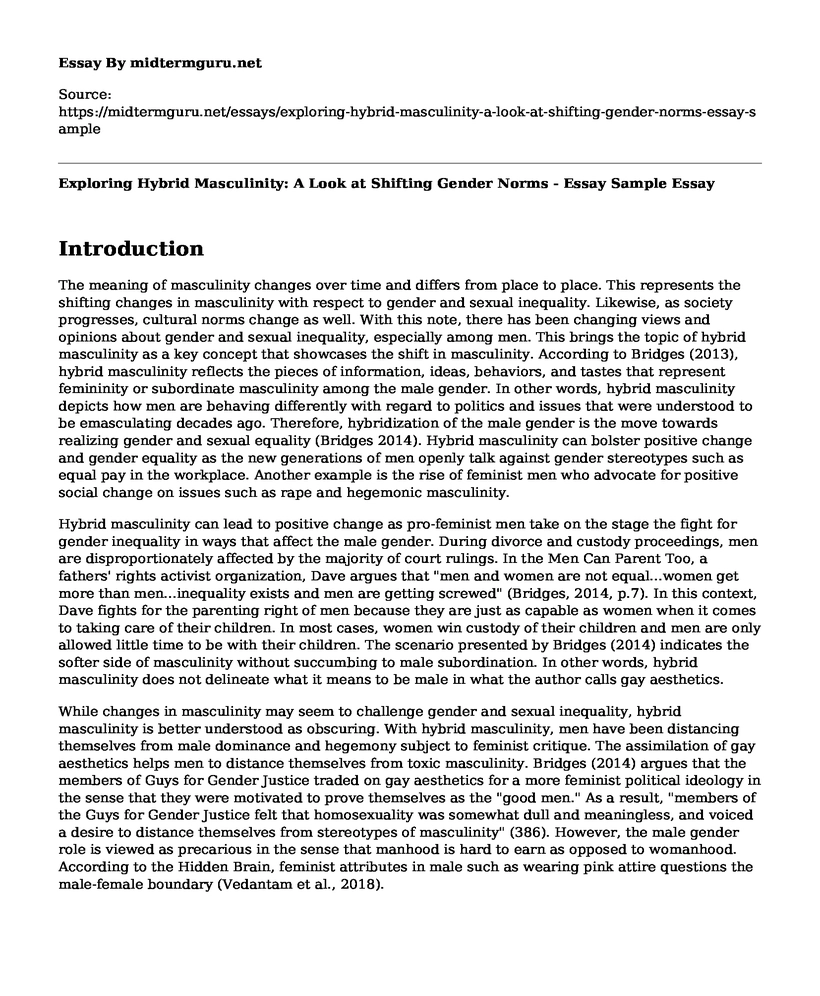Introduction
The meaning of masculinity changes over time and differs from place to place. This represents the shifting changes in masculinity with respect to gender and sexual inequality. Likewise, as society progresses, cultural norms change as well. With this note, there has been changing views and opinions about gender and sexual inequality, especially among men. This brings the topic of hybrid masculinity as a key concept that showcases the shift in masculinity. According to Bridges (2013), hybrid masculinity reflects the pieces of information, ideas, behaviors, and tastes that represent femininity or subordinate masculinity among the male gender. In other words, hybrid masculinity depicts how men are behaving differently with regard to politics and issues that were understood to be emasculating decades ago. Therefore, hybridization of the male gender is the move towards realizing gender and sexual equality (Bridges 2014). Hybrid masculinity can bolster positive change and gender equality as the new generations of men openly talk against gender stereotypes such as equal pay in the workplace. Another example is the rise of feminist men who advocate for positive social change on issues such as rape and hegemonic masculinity.
Hybrid masculinity can lead to positive change as pro-feminist men take on the stage the fight for gender inequality in ways that affect the male gender. During divorce and custody proceedings, men are disproportionately affected by the majority of court rulings. In the Men Can Parent Too, a fathers' rights activist organization, Dave argues that "men and women are not equal...women get more than men...inequality exists and men are getting screwed" (Bridges, 2014, p.7). In this context, Dave fights for the parenting right of men because they are just as capable as women when it comes to taking care of their children. In most cases, women win custody of their children and men are only allowed little time to be with their children. The scenario presented by Bridges (2014) indicates the softer side of masculinity without succumbing to male subordination. In other words, hybrid masculinity does not delineate what it means to be male in what the author calls gay aesthetics.
While changes in masculinity may seem to challenge gender and sexual inequality, hybrid masculinity is better understood as obscuring. With hybrid masculinity, men have been distancing themselves from male dominance and hegemony subject to feminist critique. The assimilation of gay aesthetics helps men to distance themselves from toxic masculinity. Bridges (2014) argues that the members of Guys for Gender Justice traded on gay aesthetics for a more feminist political ideology in the sense that they were motivated to prove themselves as the "good men." As a result, "members of the Guys for Gender Justice felt that homosexuality was somewhat dull and meaningless, and voiced a desire to distance themselves from stereotypes of masculinity" (386). However, the male gender role is viewed as precarious in the sense that manhood is hard to earn as opposed to womanhood. According to the Hidden Brain, feminist attributes in male such as wearing pink attire questions the male-female boundary (Vedantam et al., 2018).
Conclusion
In conclusion, hybrid masculinity can lead to positive social change as men take on the stage to advocate for sexual and gender inequality. Men should not be in the sidelines when the society ravages in the realms of gender and sexual stereotypes that limit progress. The framework adopted by bridges and discussed in chapter 30 implies male activism does not necessarily mean men lose their masculinity by adopting sexual aesthetics such as gay character while remaining straight, it shows the changing dynamics of being male. Hybrid masculinity, as opposed to toxic masculinity, does not advocate for power or the domination of gender relations. Hybridization seeks to encourage men to support greater gender relations by appreciating gender differences and ways in which sexual and gender inequalities can be eradicated.
References
Bridges, T. (2014). A Very ''Gay'' Straight?: Hybrid Masculinities, Sexual Aesthetics, and the
Changing Relationship between Masculinity and Homophobia. Gender & Society,
28(1), 58-82. Doi:10.1177/0891243213503901
Vedantam, S., Shah, P., Boyle, T., & Cohen, R. (2018, October 01). 'Man Up': How A Fear
Of Appearing Feminine Restricts Men, And Affects Us All. Retrieved from https://www.npr.org/2018/10/01/653339162/-man-up-how-a-fear-of-appearing-feminine-restricts-men-and-affects-us-all
Cite this page
Exploring Hybrid Masculinity: A Look at Shifting Gender Norms - Essay Sample. (2023, Jan 18). Retrieved from https://midtermguru.com/essays/exploring-hybrid-masculinity-a-look-at-shifting-gender-norms-essay-sample
If you are the original author of this essay and no longer wish to have it published on the midtermguru.com website, please click below to request its removal:
- Impact of Training on Officer Stress
- Cognitive Behavioral Therapy (CBT) for Addiction - Paper Example
- Questions and Answers on Communication With Customers - Paper Example
- Articles Analysis Essay on Depression
- Social Context of the Society That Affects Many Parts of the World
- Article Analysis Essay on Shaping Agility Through Digital Options
- Personality: Neuroticism & Biblical Character - Essay Sample







